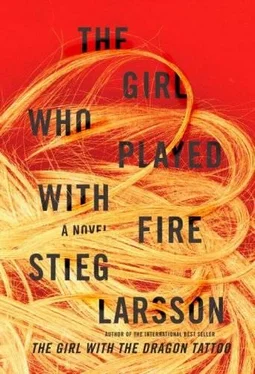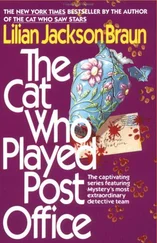His wife Agnes accompanied him for the first part of the walk. They had been married for twenty-three years, and in all that time he had never strayed.
They stopped at the synagogue for a while and talked to the rabbi. Bublanski was a Polish Jew, while Agnes’ family – the few who had survived Auschwitz – were originally from Hungary.
After visiting the synagogue they parted – Agnes to go shopping, Bublanski to keep walking. He needed to be alone, to think about the investigation. He went back over the measures he had taken since the job had landed on his desk on the morning of Maundy Thursday, and he could identify only a couple of mistakes.
One was that he hadn’t immediately sent someone to go through Svensson’s desk at Millennium. When eventually he remembered to do it – and he had done it himself – Blomkvist had already cleaned out God knows what.
Another mistake was missing the fact that Salander had bought a car. But Holmberg had reported that the car contained nothing of interest.
Apart from these two errors, the investigation had been as thorough as could have been expected.
He stopped at a kiosk near Zinkensdamm and stared at a newspaper headline. The passport photograph of Salander had been cropped to a small but easily recognizable size and the focus had shifted to a more sensational line of news:
POLICE TRACKING
LESBIAN SATANIST CULT
He bought a copy and found the spread, which was dominated by a photograph of five girls in their late teens dressed in black leather jackets with rivets, torn black jeans, and tight T-shirts. One of the girls was holding up a flag with a pentagram and another was making a sign with her index and little fingers. The caption read: Lisbeth Salander hung out with a death-metal band that played in small clubs. In 1996 the group paid homage to the Church of Satan and had a hit with “Etiquette of Evil.”
The name Evil Fingers was not mentioned, and the newspaper had blacked out their eyes, but friends of the rock group would certainly recognize the girls.
The story was mainly about Miriam Wu and was illustrated with a picture taken from a show at Bern’s in which she had performed. She was topless and wearing a Russian army officer’s cap. Her eyes were blacked out too.
SALANDER’S GIRLFRIEND WROTE ABOUT LESBIAN S&M SEX
The 31-year-old woman is well known in Stockholm’s trendy nightspots. She makes no secret that she picks up women and likes to dominate her partner.
The reporter had even found a girl he called Sara who, according to her own testimony, had been the object of the woman’s pickup attempts. Her boyfriend had been “disturbed” by the incident. The article went on to say that the band was an obscure and elitist feminist variant on the fringes of the gay movement, and that it had acquired a certain fame for hosting a “bondage workshop” at the Gay Pride Festival. The rest of the article was based on a deliberately provocative piece Wu had written six years earlier for a feminist fanzine. Bublanski scanned the text and then tossed the paper into a trash can.
He brooded over Faste and Modig, both competent detectives. But Faste was a problem; he got on people’s nerves. He would have to have a talk with the man, but he didn’t think he was the source of the leaks.
When Bublanski got his bearings again he was standing on Lundagatan staring at the front door of Salander’s building. It had not been a conscious decision to walk there.
He walked up the steps to upper Lundagatan, where he stood for a long time thinking about Blomkvist’s story of Salander’s attack. That didn’t lead anywhere either. There was no police report, no names of persons involved, and not even an adequate description of the attacker. Blomkvist had claimed that he could not read the licence plate of the van that drove away from the scene.
Assuming any of it had happened at all.
Another dead end.
Bublanski looked down Lundagatan at the burgundy Honda that was still parked in the street, and at that moment Blomkvist walked up to the front door.
Miriam Wu awoke late in the day, tangled in the sheets. She sat up and looked around at the unfamiliar room.
She had used the torrent of media attention as an excuse to call a girlfriend. But she had also left the apartment, she realized, because she was afraid that Salander might knock on her door. Her interview with the police and the newspaper coverage had affected her profoundly, and even though she had resolved not to make up her mind one way or the other until Salander had a chance to explain what had happened, she had started to suspect that her friend might actually be guilty.
She glanced down at Viktoria Viktorsson – known as Double-V and 100 percent dyke. She was lying on her stomach and mumbling in her sleep. Miriam slipped out of bed and took a shower. Then she went out to buy rolls for breakfast. It was not until she was standing at the cash register of the shop next to Café Cinnamon on Verkstadsgatan that she saw the headlines. She fled back to Double-V’s apartment.
***
Blomkvist punched in the entry code and went inside. He was gone for two minutes before he reappeared. Nobody home. He looked up and down the street, apparently undecided. Bublanski watched him intently.
What bothered Bublanski was that if Blomkvist had lied about the attack on Lundagatan then he was playing some kind of game, which in the worst case could mean that he was involved in the murders. But if he was telling the truth there was still a hidden element in the drama; there were more players than those who were visible, and the murders could be considerably more complex than an attack of insanity in a pathologically disturbed girl.
As Blomkvist moved towards Zinkensdamm, Bublanski called after him. Blomkvist stopped, saw the detective, and walked over to him. They met at the foot of the steps.
“Hello, Blomkvist. Looking for Lisbeth Salander?”
“As a matter of fact, no. I’m looking for Miriam Wu.”
“She isn’t home. Somebody leaked the news to the press that she had resurfaced.”
“What did she have to say?”
Bublanski gave Blomkvist a searching look. Kalle Blomkvist.
“Walk with me,” Bublanski said. “I need a cup of coffee.”
They passed Högalid Church in silence. Bublanski took him to Café Lillasyster, near to where Liljeholmsbron crosses the Norrström to the southern suburb of Liljeholmen. Bublanski ordered a double espresso with a teaspoonful of cold milk and Blomkvist a caffè latte. They sat in the smoking section.
“It’s been a long time since I’ve had such a frustrating case,” Bublanski said. “How much can I discuss with you without having to read it in Expressen tomorrow morning?”
“I don’t work for Expressen.”
“You know what I mean.”
“Bublanski – I don’t believe Lisbeth is guilty.”
“And now you’re doing your own private investigation? Is that why they call you Kalle Blomkvist?”
Blomkvist smiled. “They tell me you’re called Officer Bubble.”
Bublanski gave him a stiff smile. “Why do you think Salander is innocent?”
“I don’t know a thing about her guardian, but she had no reason whatsoever to murder Dag and Mia. Especially not Mia. Lisbeth loathes men who hate women, and Mia was in the process of putting the screws to a whole bunch of prostitutes’ clients. What Mia was doing was completely in line with what Lisbeth herself would have done. She is a very moral creature.”
“I can’t seem to piece together a coherent picture of her. A retarded psycho case or a skilled researcher?”
“Lisbeth is just different. She’s abnormally antisocial, but there is definitely nothing wrong with her intelligence. On the contrary, she’s probably smarter than you or me.”
Читать дальше












